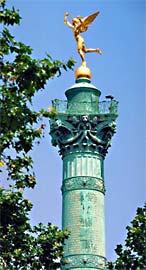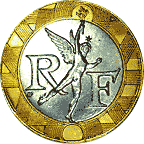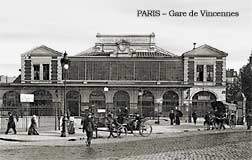| |||||||||||||
| |||||||||||||

|
|
|||

July Column, Place de la Bastille. The July ColumnAs early as 1792, some form of commemoration of the French Revolution had been contemplated for the Place de la Bastille. In fact, the demolitionist of the old prison fortress, Pierre-François Palloy, had even laid the first stone of the base for the proposed monument — but no further progress was made to build it for another forty years. The impetus for its construction, as it happened, was another French revolt: the Revolution of 1830. Also known as the July Revolution, this was a revolt by the middle class against Bourbon King Charles X which forced him out of office and replaced him with the Orleanist King Louis-Philippe, creating a constitutional monarchy. (see expanded article here) In 1833, Louis-Philippe decided to have a monument constructed which would commemorate both the French Revolution of 1789 (the storming of the Bastille) and the "three glorious days" of the July (1830) revolt. It was finally inaugurated on July 28, 1840. The column is located on an island in the middle of a very busy traffic circle that is Place de la Bastille, roughly where the medieval Porte Saint-Antoine once stood. It is engraved in gold with the names of Parisians who died during the 1830 revolt. As many as thirty of these revolutionaries are said to be buried in vaults under the column. At the top of the column stands a gold-leafed bronze statue called the Génie de la Liberté (the Spirit of Freedom), designed by sculptor Augustin-Alexandre Dumont. This same figure also appeared on the reverse side of newer French ten-franc coins, minted from 1988 through 2000 (no longer in circulation today, since the Euro is now the national currency). 
10-franc coin (1995) Source: Monnaie de Paris (the French Mint) On a plaque, at the base of the column, is this inscription:
The Area TodayThe former location of the ancient fortress is called the Place de la Bastille. It is one of the city's most congested traffic circles, serving as the confluence for no fewer than thirteen different streets: Boulevards de la Bastille, Bourdon, Henri IV, Beaumarchais, and Richard Lenoir; Rues de la Bastille, de la Roquette, du Faubourg Saint-Antoine, de Charenton, de Lyon, and Saint-Antoine; Cour Damoye and Passage du Cheval Blanc. Three Paris arrondissements are joined at this intersection: the 4th, 11th, and 12th. (If you have the Quicktime plug-in, you can view a 360° virtual-reality panorama.) Until 1988, there was little more to see here than a huge traffic circle and the Colonne de Juillet (July Column), commemorating the overthrow of Charles X in July 1830. As part of the nationwide celebrations for July 1989 (bicentennial of the French Revolution), the Opéra de la Bastille was erected at the site of the former Gare de Vincennes, inspiring substantial redevelopment on the surrounding streets. What was formerly a humdrum working-class neighborhood rapidly gained chic art galleries, shops, theaters, funky jazz clubs, restaurants and bars — and it is now one of the trendiest sections of Paris. 
Postcard of the Gare de Vincennes, around the turn of the 20th century. (click on photo for larger view) At the southern edge of the Place is a square which is currently a popular hangout for skate-boarders practicing their tricks on portable ramps. Underneath this square is the Bastille station of the Paris Métro (lines 1, 5, 8). The square also overlooks the Porte de Plaisance de Paris-Arsenal, a marina with over 200 slips for various riverboats and pleasure craft, situated on the first stretch of the Canal Saint-Martin — which starts from the River Seine (separated by locks) and proceeds underground for several kilometers. Tourists can board a péniche for a narrated cruise of the Canal, passing under the old foundations of the ancient Bastille fortress, then resurfacing after tracing the boulevard Richard Lenoir, to pass through several more locks and rotating bridges before emerging at the Bassin de la Villette. To the right of the Opéra de la Bastille, on avenue Daumesnil, one can ascend a flight of stairs to access the Promenade Plantée or Coulée Verte — a unique garden planted the length of an old railway viaduct (Viaduc des Arts), offering a pleasant stroll as far as the Bois de Vincennes at the boundary of Paris. GO TO NEXT PAGE » Related Links, Recommended Resources, Bibliography |
|||

|
||||||||||